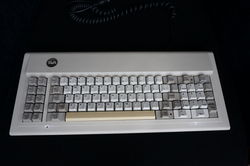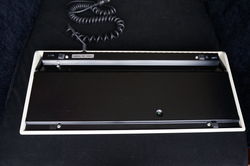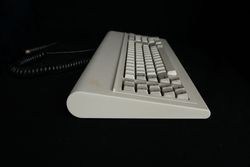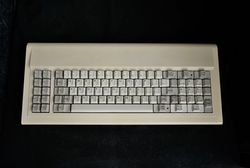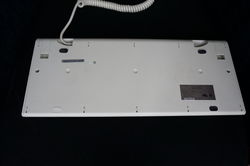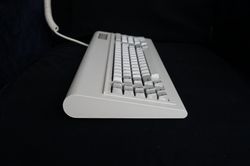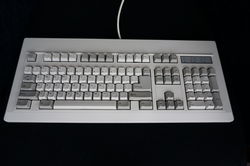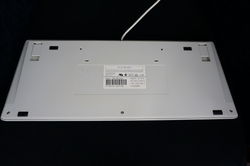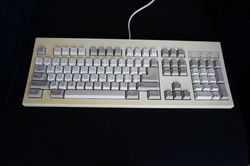Hi-Tek Series 725 keyboards
Hi-Tek Series 725 was Hi-Tek Corporation's DIN-compliant keyboard series, introduced in 1983; the name refers to how these keyboards are a maximum of 0.725″ from the desk surface.[1]
Series 725 was introduced by Hi-Tek shortly before their acquisition by Minebea. The name does not refer to any particular size or shape of keyboard, but rather to the reduction in desk-to-keycap height that was made possible by the use of compact switches.
See:
- Hi-Tek Series 725 first generation: typically Model F clone layout
- Hi-Tek Series 725 second generation: typically Model F clone layout
- NMB RT-100/RT-8200 series: full-size keyboards; later variants gained Windows keys
Contents
History
In 1983 Hi-Tek Corporation introduced Series 725, a DIN-compliant keyboard design using a new design of switch. Series 725 keyboard production continued into the 1990s. This page serves as an overview of the various Hi-Tek and NMB keyboards produced during that period. Changes made during production are touched upon with goal of differentiating the various generations of keyboards. More detail about the switches available for a specific keyboard or during a given time, as well as in-depth photographs, can be found on the separate pages dedicated to each generation.
Keycaps
All Hi-Tek and NMB keyboards use PBT keycaps with dye sublimated legends. The one exception to this rule is the space bar on the earliest keyboards which was ABS. To achieve a low profile, the keycaps clip on top of the slider.
Generations
The design of Hi-Tek (later NMB) keyboards underwent five generational changes.
First generation (1983–1986)
The first generation is typical of keyboard case design of the era. The upper case is a single piece of relatively thick injection-moulded plastic that is finished with a painted coating that has a splattered texture. The back cover of the case is a flat black plate with a V bend running the length of the case. The rear cover attached to the upper case with screws. Earlier first-generation cases use a metal rear cover. Later cases switched to a black plastic cover that mimics the design of the earlier metal covers.
The first generation had three styles, XT, AT and 122 key.
XT
The XT style looks very similar to the Key Tronic Model F clone series from the same period. From the front they look nearly identical. From the rear, the feet on the NMB Hi-Tek are at the very edge of the back cover while the Key Tronic are inset slightly. The key layout is very similar to the IBM Model F PC/XT keyboard.
AT
The AT style borrows from the IBM Model F AT keyboard, although it lacks the status LED panel. Status LEDs are in the keycaps. The layout is identical to the 84 key IBM AT layout.
122 Key (3270)
The 122 key style is identical to the original IBM 3270 PC keyboard.
Second generation (1985-1988)
The second generation switched to a thinner plastic. No painted coating was used on the upper case. The surface texture was part of the moulding process. The rear cover is also plastic and matches the colour of the upper case. The rear cover features two cable ports which are marked "Keyboard" and "Mouse" along with a grille opening with an unknown purpose. The rear cover is attached to the upper case with a number of tabs that slide to interlock. The rear cover and upper case are held in place by two screws. The feet are black plastic with rounded ends.
The XT and AT styles from the first generation carry over to the second generation.
XT
As with the first generation, the XT style is similar to the Key Tronic keyboards with a PC/XT key layout.
AT
The AT style borrows from the IBM Model F AT keyboard. Like the first generation, early second generation AT style keyboards lack the status LED panel, opting to have the status LEDs within the keys. Later second-generation AT style keyboards added a status panel very similar to that on IBM AT keyboard. The feet are plastic, matching the colour and texture of the lower case half. When retracted, the feet are flush with the surface. The large keys of the alpha group have a stepped outer edge that is very distinctive of Hi-Tek keyboards of this era.
Third generation
The third generation uses injection moulded upper and lower case halves. Unlike the second generation, the third generation lower case half features only one cable port. The lower half also features a cable channel that allows the cable to be routed to the left or right side of the keyboard and provides strain relief. The feet from the second generation carry over to the third. The two case halves are held together with locking tabs and screws. Four tabs in the lower half snap and lock into recesses in the upper half. Two screws are then added to secure the attachment.
The style of the third generation case is modelled after the IBM Enhanced Keyboard. It shares a similar wedge profile and overall size, but lacks the curved recess at the edge of the key aperture. The key layout is based on the 101 key layout of the Model M, but retains the enter key from that Model F AT keyboard as well as the 1-unit backspace. The stepped keys at the edges of the alpha group were inherited from the AT style of second generation keyboards.
Fourth generation
The fourth generation uses injection moulded upper and lower case halves. The lower half has no cable channel. The cable exits from the rear of the case on the right side where the upper and lower cases come together. The feet are similar to but shorter than the feet of the fourth generation. The feet also flush with the bottom of the case when retracted. The two case halves are held together using 8 screws. No locking tabs are used.
The style of the fourth generation case is often described as being flatter than the previous generation. The bevelled edge at the front of the case is reminiscent of other keyboard designs such as Cherry 3000 style and that of SMK second generation platform. The 101-key layout from the third generation carries over to the fourth generation including the AT enter key and 1-unit backspace. The distinctive stepped outer edge of the large keys of previous generations was eliminated in the early in production, but a few fourth-generation keyboards can be found with the stepped key caps. In top view, the fourth generation can be distinguished from third generation by the bevel at the front edge which exists on the fourth generation. The fourth generation was the first to offer a PS/2 connector option.
Fifth generation
The fifth-generation case is constructed in a similar manner to the fourth generation. Upper and lower halves are injection moulded. The cable exits the right rear of the case where the halves are joined. The feet are identical to the fourth generation.
The fifth generation uses a reduced footprint design that is similar to most keyboards of the era. The area of the case above and below the keyboard has been significantly reduced to yield a case that is just larger than the key area. Key layout is identical to the fourth generation.
References
- ↑ Deskthority — Hi-Tek Corp. History Posted 2014-04-11. Retrieved 2024-03-29.
